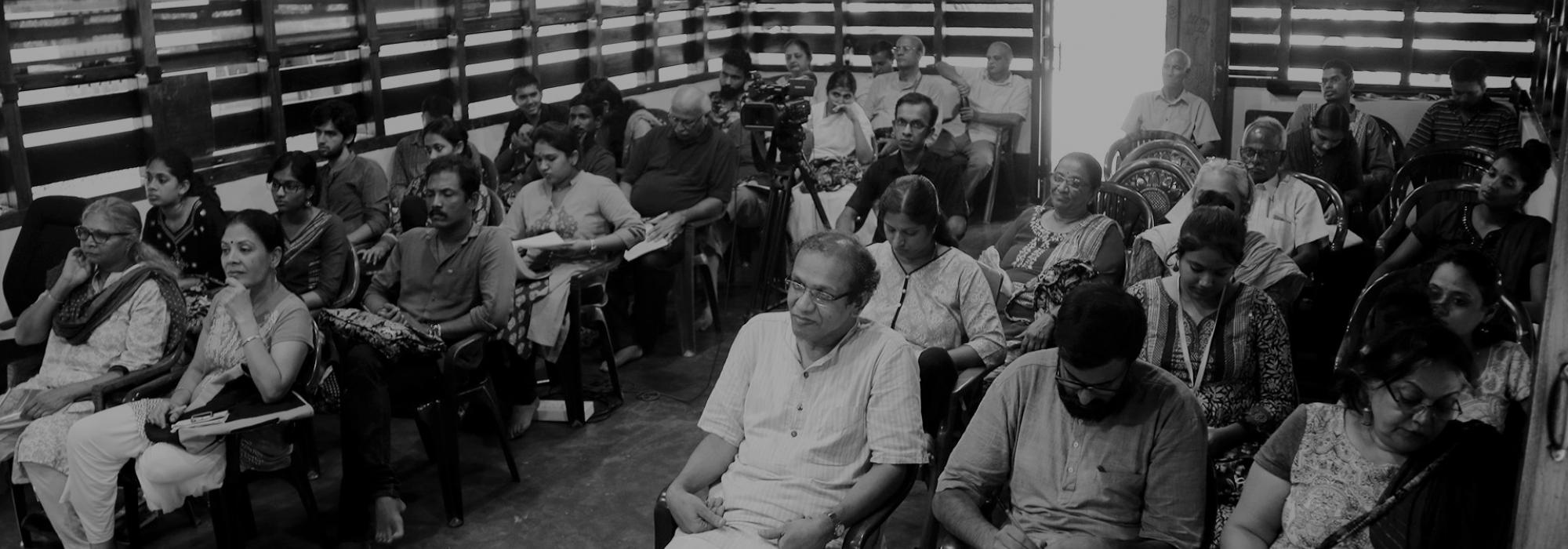Arjun Bharadwaj started off the day’s proceeding with the fourth session of kavya-samskrtam, which has been a regular morning activity of the summer school. In this session, Shashi and Arjun have helping understand and appreciate the beauty of a few Sanskrit verses. In today’s session, Arjun covered five verses from Lilashuka’s Krishnakarnamrtam. While explaining the nuances of the verse with respect to grammar, prosody, etc. he also brought out the various suggestions (dhvani) in those verses.
Day 6, Session 1: Meghadutam, Rtusamhara
Shatavadhani Dr. R Ganesh
In the earlier sessions on Kalidasa’s Meghadutam, Dr. Ganesh had given an overview of the work and had shown the participants how to enjoy the inherent poetry. He had also mentioned that in this poem, time is a constant (monsoon) but the space varies (the Indian landscape).
One of the striking features of Meghadutam is the use of vakrokti (oblique expression). Kalidasa’s attention to detail beautifully blends nature and culture, without ever overlooking variety and novelty. His love for his homeland is seen in many verses. It is a poetic convention to consider laughter as white in colour. While describing the Himalayas, he says that it looks like the white laughter of Shiva, the unmatta jivanmukta. The Yaksha asks the cloud to solidify itself and form a staircase to assist Parvati when she’s trying to climb the Himalayas.
Kubera, the lord of the Northern direction, rules over the Alakavati. And since he’s a deity, space and time don’t matter to him and the six seasons exist simultaneously in his town. Kalidasa speaks of all the six seasons in a single verse – not explicitly – but by mentioning seasonal flowers.
In Meghadutam, Kalidasa uses the word raga in the technical musical sense and he’s the first person to do so. Previously in the Natyashastra, it was termed jati.
Speaking about the Rtusamhara, another work of Kalidasa, Dr. Ganesh made an interesting observation that the tropic of cancer passes through central India and hence all six seasons are present in a distinguishable way. Rtusamhara is the first kavya whose topic is the description of seasons. He describes the seasons in the following order: Grishma, Varsha, Sharat, Hemanta, Shishira, and Vasanta. Dr. Ganesh also mentioned parallels from other works of Kalidasa such as Raghuvamsham, Vikramorvashiyam, and Abhijnana Shakuntalam.
Day 6, Session 2: Raghuvamsham
Shashi Kiran B N
The benedictory verse of Raghuvamsham has risen to the level of a mantra:
वागर्थाविव सम्पृक्तौ
वागर्थप्रतिपत्तये ।
जगतः पितरौ वन्दे
पार्वतीपरमेश्वरौ ॥
Historically, this was treated as a text to introduce Sanskrit literature to students but yet its importance as a great epic was never forgotten. It is equally appreciated by both vyutpitsu and vyutpanna. In this epic, various kings embody the essence of purusharthas. It describes the varna and ashrama dharmas as well.
Interestingly, Dr. V Raghavan describes Raghuvamsham as “a saga of love through the ages.” Kalidasa’s epics Raghuvamsham and Kumarasambhavam teaches us that true love transcends gender.
Drawing from the descriptions of sages and hermitages from Banabhatta’s Kadambari, Shashi explained how the Indian ethos has been preserved in the Sanskrit epic tradition. Explaining the description of Vasishta’s hermitage, he drew the audience’s attention to the subtle details in the lives of hermits that Kalidasa portrays.
Day 6, Session 3
Shatavadhani Dr. R Ganesh
Dr. Ganesh answered questions raised by the participants in this session. Here are a few select questions and the answers given:
Q. All our epics speak of social values. How do we bring them back into modern society?
A. First, we shall bring it into ourselves. If there is no one to take up things that we live, we should do it ourselves. If we do this, at least one fool will be eliminated from the earth. This has to be the mindset of Indians in the present context. We can derive inspiration from the Vaidika Rashtragita.
Q. I’m seeking clarity on the nature of friendship. How do you compare the friendship of Duryodhana-Karna with that of Krishna-Arjuna?
A. With Duryodhana and Karna, it was a friendship of convenience. Karna wanted power and social recognition, while Duryodhana saw a potential candidate to fight the Pandavas. However, in timed of adversity, their egos and their selfish motives came in the way of their friendship. Right should follow might – balam dharmonuvartate – was the refrain of Karna and all his efforts went in abetting the crimes of Duryodhana. Karna always felt indebted to Duryodhana; this was a burden which proved to be destructive.
With Krishna and Arjuna, it was a natural friendship and they had no material transactions. Krishna never made Arjuna feel small in front of him. Arjuna became powerless after Krishna’s death and couldn’t survive for long thereafter. When he was given a choice to choose between the Narayani sena and Krishna himself, he chose the latter. Given a choice between persons and positions, Arjuna, like an ideal friend, chose the former.
Day 6, Session 4. Sanskrit Works on the Theme of Ramayana
Shatavadhani Dr. R Ganesh and Shashi Kiran B N
This session focused primarily on natakas and mahakavyas. The following works were covered – among the plays: Pratimanataka and Abhishekanataka of Bhasa, Mahaviracharita and Uttararamacharita of Bhavabhuti, Balaramayana of Rajashekhara, Anargharaghava of Murari, Prasannaraghava of Jayadeva, Ashcharyachudamani of Shaktibhadra, Kundamala of Dinnaga, and Hanumannataka; among the kavyas: Ramacharita of Abhinanda, Ravanavadha of Bhatti, Janakiharana of Kumaradasa, Janakiparinaya of Chakrakavi. Many other stotra- and gita-kavyas were covered.
The day ended with short music and dance concerts by the participants and the faculty of the summer school.
Cover photo courtesy Chinmaya International Foundation.













































